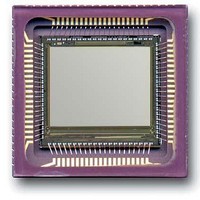CYII5SC1300-EVAL Cypress Semiconductor Corp, CYII5SC1300-EVAL Datasheet - Page 9

CYII5SC1300-EVAL
Manufacturer Part Number
CYII5SC1300-EVAL
Description
BOARD EVAL IMG SENS IBIS5-B-1300
Manufacturer
Cypress Semiconductor Corp
Specifications of CYII5SC1300-EVAL
Sensor Type
CMOS Imaging, Color (RGB)
Sensing Range
1.3 Megapixel
Interface
Parallel/Serial
Sensitivity
106 fps
Voltage - Supply
3 V ~ 4.5 V
Embedded
No
Utilized Ic / Part
IBIS5-B-1300
Lead Free Status / RoHS Status
Contains lead / RoHS non-compliant
Lead Free Status / RoHS Status
Lead free / RoHS Compliant, Contains lead / RoHS non-compliant
Document #: 38-05710 Rev. *A
Due to these delays it is advised that a variable phase
difference is foreseen between the ADC_CLOCK and the
SYS_CLOCK to tune the optimal sample moment of the ADC.
Setting of the ADC Reference Voltages
The internal resistor R
This results in the following values for the external resistors:
Note that the recommended ADC resistors value yields in a
conversion of the full analog output swing at unity gain
(V
ADC_VLOW).
The values of the resistors depend on the value of R
voltage difference between ADC_VLOW and ADC_VHIGH
must be at least 1.0V to assure proper working of the ADC.
R
R
R
ADC_VHIGH
ADC
ADC_VLOW
DARK_ANALOG
Figure 11. In- and External ADC Connections
ADC_VHIGH ~ 2.7V
ADC_VLOW ~ 1.8V
Resistor
< ADC_VHIGH and V
ADC
has a value of approximately 585 Ω .
R
ADC
R
R
external
external
ADC_VHIGH
ADC_VLOW
internal
Value (O)
LIGHT_ANALOG
1200
360
585
Figure 10. ADC Timing
ADC
. The
>
Non-linear and Linear Conversion Mode—“gamma” Correction
Figure 12 on page 10
The non-linear (exponential) ADC conversion is intended for
gamma-correction of the images. It increases contrast in dark
areas and reduces contrast in bright areas. The non-linear
transfer function is given by:
With:
a = 5
b = 0.027
x = digital output code
Electronic Shutter Types
The IBIS5-B-1300 has 2 different shutter types: a rolling
(curtain) shutter and a snapshot (synchronous) shutter.
Rolling (Curtain) Shutter
The name is due to the fact that the effect is similar to a curtain
shutter of a SLR film camera. Although it is a pure electronic
operation, the shutter seems to slide over the image. A rolling
shutter is easy and elegant to implement in a CMOS sensor.
As can be seen in
registers. One of them points to the row that is currently being
read out. The other shift register points to the row that is
currently being reset. Both pointers are shifted by the same
Y-clock and move over the focal plane. The integration time is
set by the delay between both pointers.
In
integration times of different lines during the rolling shutter
operation. Each line is read and reset in a sequential way. The
integration time is the same for all lines, but is shifted in time.
The integration time can be varied through the INT_TIME
register (in number of lines).
This indicates to us that all pixels are light sensitive at another
period of time, which can cause some blurring if a fast moving
object is captured.
When the sensor is set to rolling shutter mode, the input
SS_START and SS_STOP must best be held low.
Vin
Figure
=
ADC_VHIGH
13, we schematically indicate the relative shift of the
+
(
Figure 13 on page
ADC_VHIGH ADC_VLOW
shows the ADC transfer characteristic.
–
CYII5FM1300AB
10, there are two Y shift
IBIS5-B-1300
) *
---------------------------------------------- -
a*1023
a*x
Page 9 of 42
+
+
b*x
b*1023
2
2
[+] Feedback










